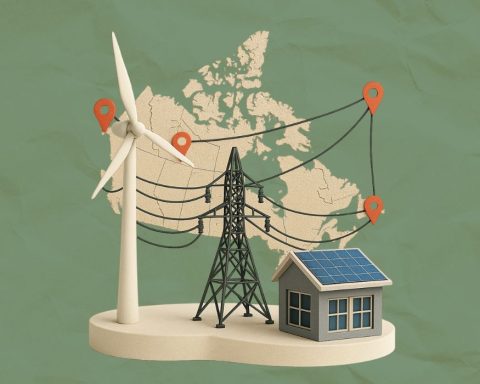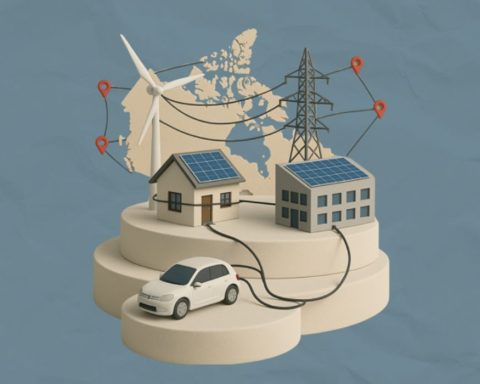If an all-renewable electricity grid is the backbone of Canada’s shift to a zero-carbon economy by 2050, our buildings and road transport systems are the flesh and blood.
Extensive new modelling by Corporate Knights’ Climate Dollars project reveals that the rapid transformation we need is within our grasp. But the buildings and transport sectors each hold an essential piece of the solution.
- Any successful effort to bring Canada’s greenhouse gas emissions to zero by 2050 must shift the entire building stock to use heat pumps for space heating and cooling, while striking the best balance in each province between the cost and benefits of deep energy-efficiency retrofits.
- The Climate Dollars modelling places the batteries in electric vehicles at the centre of the decarbonization effort. Vehicle-to-grid (V2G) systems allow EVs to charge when solar and wind are abundant and cheap, then release part of that charge to the grid when demand is highest, reducing the cost of decarbonizing by $8,000 per vehicle – as long as those millions of EVs are on the road in time to make a difference.
The analysis shows that decarbonizing our energy system by mid-century will be a big, bold nation-building project in which every sector plays an essential part. We can meet that target faster and at less cost by looking at the electricity system, buildings and road transport as an integrated whole, rather than trying to shift each sector on its own.
Climate Dollars modelling points to a realistic path to eliminate Canada’s energy-related greenhouse gas emissions by 2050. It’s achievable and affordable, requiring a manageable share of the capital dollars the country already invests each year. It delivers hundreds of thousands of well-paying jobs in the rapidly emerging new energy economy.
The capital expenditure gap in buildings and transport
Corporate Knights set up the Climate Dollars project to measure the gap between current climate-related capital investments and the funding required to meet the country’s climate goals. Much of that investment will be for the renewable electricity supply and a project we’re calling the Trans-Canada Transmission Link that deliver the renewable energy to power Canada’s buildings, vehicles, industry and agriculture.
The other key pillars of any decarbonization plan are to make each of those sectors as energy-efficient as possible and shift their consumption from fossil fuels to clean electricity. The Climate Dollars modelling shows those changes increasing electricity demand from less than 600 to nearly 1,000 terawatt-hours per year, including 490 TWh in homes and commercial buildings and 150 TWh from road transport.
The other key pillars of any decarbonization plan are to make each of those sectors as energy-efficient as possible and shift their consumption from fossil fuels to clean electricity. The Climate Dollars modelling shows those changes increasing electricity demand from less than 600 to more than 1,000 terawatt-hours per year, including about 335 TWh in homes and commercial buildings and up to 290 TWh from road transport.
Both of these sectors can make it easier and less expensive for the grid to decarbonize. But only if they can clear a large gap between current capital expenditures and the levels that will be needed to get the job done.
For Canada’s nine million residential buildings and one million commercial buildings, the two decarbonization scenarios in the Climate Dollars analysis require additional capital expenditures between $14 billion and $35 billion per year through 2050. The more ambitious scenario, combining heat pump conversions with deep energy retrofits in the residential sector, reduces electricity consumption in all provinces but Alberta, Saskatchewan and Ontario. Heat pump conversions without the efficiency upgrades cost far less but increase the investment needed to ensure a renewable electricity supply through the winter months.
RELATED:
How transforming Canada’s electricity grid could drive decarbonization, save billions
Three big shifts that can transform and modernize Canada’s economy
Closing the climate funding gap is key to Canada’s prosperity
In response to the affordable housing crisis, Canada will also see construction of hundreds of thousands of new residential buildings by 2030, the majority of them multi-family structures. They’ll all have to be built to the highest possible energy-efficiency standard and equipped with air-source or ground-source heat pumps, not fossil-fuelled heating or cooling.
In transport, additional capital investment of $270 to $300 billion over the next 25 years will be needed to complete the shift to electric vehicles and install 555,000 new public charging stations, with V2G technology turning the batteries in those cars into a valuable grid resource. Annual investment peaks at $17.5 billion in 2032 and then starts falling as the cost premium for personal EVs declines throughout the 2030s.
Decarbonizing buildings means investing in ourselves
Every aspect of the Climate Dollars modelling points to the investments that will make Canadians’ lives safer, healthier and more affordable. The buildings sector is where the response to climate change literally comes home. Our buildings must be electrified and prepared for the extreme weather that is already locked and loaded in the atmosphere as a result of past and present greenhouse gas emissions. Heat pumps and efficiency improvements in our building stock are also essential enabling investments for the electricity supply sector to be able to make the transition to a renewables-based grid. In a cascading, global climate emergency, the simplest, cheapest path to reduce the greenhouse gas emissions from building energy use is to replace fossil-fuelled heating and cooling with heat pumps at a cost of $370 billion through 2050, or about $13.6 billion per year.
More extensive building retrofits deliver benefits far beyond energy savings and emission reductions. They help protect our homes and businesses from storms and flooding, wildfires, heat waves and power outages that will become more severe and frequent as the years go by. A national energy-retrofit mission would create hundreds of thousands of jobs in a thriving, new business sector, helping to build stronger communities and avert the worst impacts of climate change.
Every aspect of the Climate Dollars modelling points to the investments that will make Canadians’ lives safer, healthier and more affordable.
Even assuming that economies of scale bring down the cost of building retrofits by 50% by 2035, it would take an additional $500 billion over the next 25 years, an average of $20 billion per year, to recondition the entire building stock. Canadians actually invest much more than that in existing buildings; in 2024 alone capital expenditures on building renovations totalled $101 billion in the residential sector and $28 billion in the commercial sector.
But while those improvements included some energy-efficiency upgrading, the priorities for building upgrades are generally directed more toward interior redecoration and refitting. This is a recurring theme in the analysis of decarbonization – it is not so much an increase in the total capital that is required but rather shifts in the way capital is allocated, projects are planned and organized, a new work force is trained and deployed, and government incentives are designed for building retrofits.
Road transport is already decarbonizing
In road transport, the shift from internal combustion to electric vehicles is already well under way. Electric vehicle sales in Canada are growing exponentially. And with the price gap expected to narrow through 2035, drivers can look forward to a clean-energy dividend on fuel of up to $1.2 trillion through 2050, after subtracting the cost of the electricity to run the vehicles.
But we’ll have to move quickly to seize the moment. The average car or light truck stays on the road for 15 years, and some commercial trucks even longer, so getting to a zero-emission fleet by 2050 means phasing out new gasoline and diesel vehicles by 2035.
Climate Dollars calculates a capital expenditure gap of $300 billion to fully electrify road transportation, including the cost of a V2G-enabled charging infrastructure. But that’s based on the assumption that the price difference between internal combustion and electric vehicles will gradually decline, reaching parity in the 2030s, with EVs then becoming less expensive than gasoline- and diesel-powered vehicles. If there were no price difference today, the capital cost of electrifying the entire road transport sector would tumble to just $57 billion between 2025 and 2050.
Decarbonizing car culture
Cars and trucks have shaped the urban form of our communities and the supply chains that sustain them for the last century. Canadians travelled an average 12,000 kilometres per person per year in 2022, not counting long-distance trips, and made 82% of those trips in cars and light trucks.
Given this heavy reliance on private vehicles, the Climate Dollars analysis shows only one viable path to decarbonizing transportation by 2050.
The sector can and should achieve some emission reductions by cutting down on the number and distance of car and truck trips, boosting public transit, moving more freight by rail, and over the short term, making internal combustion vehicles more fuel-efficient. Those are all worthy and important steps to take.
But bringing every part of the transportation system to zero emissions by 2050 must begin with rapid electrification for a fleet of cars, pickups, SUVs and commercial trucks. Along the way, vehicle-to-grid technology will dramatically reduce the cost of delivering a decarbonized electricity grid.
* * *
Corporate Knights will soon be releasing the full Climate Dollars analysis to drive discussion on the opportunities ahead, and how Canada can align with the investment strategies that allies in the European Union and elsewhere are already pursuing.
Corporate Knights is able to carry out this research thanks to support from the McConnell Foundation, the Trottier Family Foundation, the Chisholm Thomson Family Foundation and the Graham Boeckh Foundation.
The Weekly Roundup
Get all our stories in one place, every Wednesday at noon EST.







